Intel Pentium 4 6xx and 3.73EE: Favoring Features Over Performance
by Anand Lal Shimpi & Derek Wilson on February 21, 2005 6:15 AM EST- Posted in
- CPUs
An Interesting Observation: Prescott 2M's Die
What has been true for a number of modern day microprocessors is that the vast majority of the CPU is made up of cache, take a look at the Athlon 64 FX with its 1MB L2 cache:
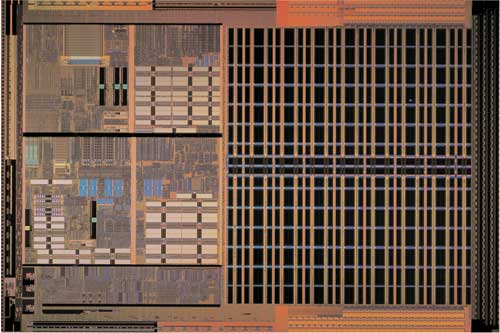
AMD Athlon 64 FX die (the large block to the right is its 1MB L2 cache)
Over half of the die is L2 cache.
But when looking at the new Prescott 2M core the same can't be said:
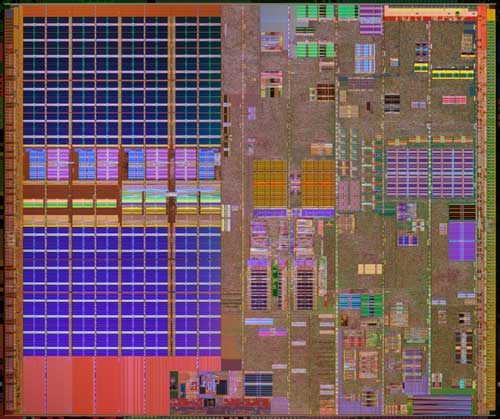
Intel Pentium 4 600 series die (the large block to the left is its 2MB L2 cache)
The split between logic and cache is almost 50/50, looking back at the original Prescott we see that the Prescott core itself actually occupied more die area than the cache:
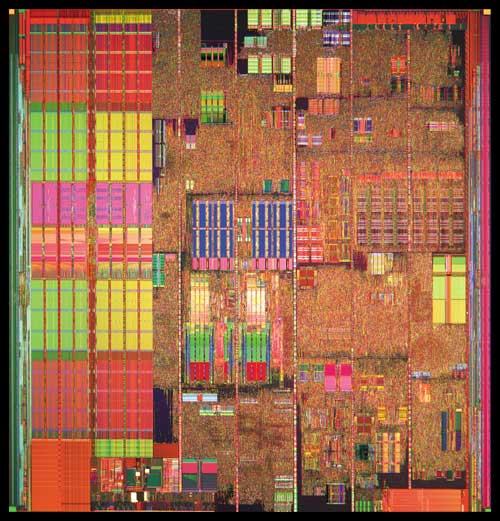
Intel Pentium 4 500 series (the block to the left is its 1MB L2 cache)
There are two explanations for the phenomenon, first with Prescott Intel introduced their highest density cache ever produced; at present day it holds the record for largest cache with the smallest area on a modern desktop microprocessor. Secondly, is the fact that Prescott, with its 31 pipeline stages, 64-bit execution units and highly accurate branch predictors with massive branch history tables, is simply a big, complex core. Also remember that the Athlon 64 is basically a reworked K7 core, with wider execution units and datapaths, as well as an on-die memory controller, so it is understandably simpler.
Let's compare that to the Pentium M:
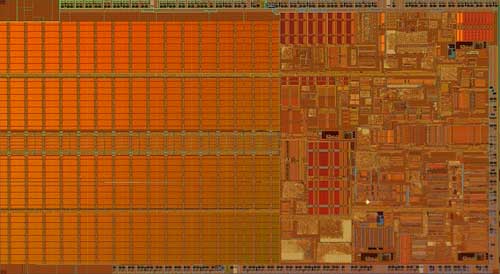
Intel Pentium M 90nm (the large block is its 2MB L2 cache)
The PowerPC 970 (used in Apple's G5 systems) looks a bit more Prescott like, but remember we're only dealing with a 512KB L2 cache here:
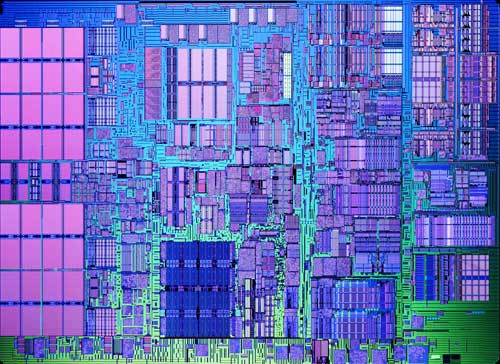
IBM PowerPC 970 (the block to the left is its 512KB L2 cache)
Or, even more interestingly, compare it to the newly announced Cell processor:

IBM/Sony/Toshiba Cell microprocessor (we apologize for the quality of the die shot, it's the best we could find)
Looking at Cell is quite interesting because it appears to be just as complex as Prescott, but remember that with Cell we're looking at 9 individual processors. But more on that next week...
Extreme Edition - Not so "Extreme" Anymore
Back when the Extreme Edition was first launched, the Pentium 4 had a "meager" 512KB L2 cache compared to the EE's 2MB L3 and 512KB L2. Now that the Pentium 4 has a 2MB L2 cache and is based off of the same core as the EE, the only benefit that the Extreme Edition offers is 1066MHz FSB support and a slightly higher clock speed.
We looked at the impact of the 1066MHz FSB in the past and quickly found that it didn't do much for the EE. Although we're now running at 3.73GHz for the Pentium 4 Extreme Edition, the benefit from the 1066MHz FSB is still pretty limited.
As for the clock speed advantage, the fastest Pentium 4 6xx is the 660, running at 3.60GHz - 96.4% of the clock speed of the 3.73GHz Extreme Edition - the clock speed difference is effectively nothing.
But the price? The 3.73 EE will retail for $999, the Pentium 4 660: $605. The Extreme Edition was never a good value, but in the case of the new chip, it's basically throwing money away. Let the benchmarks speak for themselves, but your best bet is to wait for the next generation of Extreme Edition CPUs, either with a 4MB L2 cache or the dual core offerings.










71 Comments
View All Comments
L3p3rM355i4h - Monday, February 21, 2005 - link
#30 90mm SOI= lower wattage.Brian23 - Monday, February 21, 2005 - link
Look at the power consumption graph for the A64. Why is the 3500 winchester doing so much better than the 3000 and 3200 winchesters?L3p3rM355i4h - Monday, February 21, 2005 - link
#28 saw almost the same thing at PCPER too.Aenslead - Monday, February 21, 2005 - link
I could ALMOST swear I saw the VERY same bencmarks last night @ xbit labs... fancy that.bldckstark - Monday, February 21, 2005 - link
227 WATTS!!... My daughter has a crayon maker. It uses a 60W light bulb in a plastic box to melt 3 crayons and pours them into a mold. It melts the wax in about 5 minutes. If I buy a P4 I can melt 11.35 crayons at once. It uses 3.78 times as much energy as is necessary to light my computer room. This is not efficient use of resources.L3p3rM355i4h - Monday, February 21, 2005 - link
sorry to go off topic, but are the forums down or does this terminal suck?LoneWolf15 - Monday, February 21, 2005 - link
From a price/performance standpoint, I can't see many good reasons to buy a P4 six series, and in many cases, a five series either (exceptions being high-end 3D rendering apps and heavy video encoding). Not just because of what price of processor (which doesn't seem to net a huge speed increase) but the increased power draw means a heavier power supply, plus more expensive cooling. Compared to the lower power draw of the Athlon 64 CPU's, as well as a lower price at least at the entry-to-mid level CPU's, I think Intel really needs to go back to basics and create a new CPU architecture.mlittl3 - Monday, February 21, 2005 - link
Okay, I have an addition to my last comment made about the Extreme Edition being a scam. I did some calculations that were left out my anandtech to see if the 3.73EE is truely better than the 3.46EE.Everyone knows the differences between the two processors. The 3.73EE has an 8% increase in CPU speed, less total cache overall but 4x the lower latency L2 cache when compared to L3 cache (the XD-bit and EM64T are also added but that will not effect performance at all with 32-bit OS).
With these added features, the 3.73EE should be better than the 3.46EE especially since the Prescott core is supposed to scale well with clock speed versus the Gallatin/Northwood and the 1066 MHz FSB is supposed to give better performance at higher clock speeds. Well, let's look at the numbers.
Using Anandtech's results, I calculated the % difference between the two processors. They varied between -10 (worse) and 30 % (better). I then added up all the scores (I took the inverse of the less is better scores) and divided them by the introduction price ($999) and the MHz of each processor. Here are the results.
Performance per $:
3.46EE - 20.69
3.73EE - 20.61
Performance per MHz:
3.46EE - 5.96
3.73EE - 5.52
You can do the calculations yourself by using all the benchmark numbers from the two extreme edition CPUs in the review. As you can see, the 3.73EE is worse on a per dollar and per MHz basis compared to the 3.46EE (even though the margin is small, it is still worse for the higher clocked CPU). The Prescott core is a failure IMHO. The 3.73EE is a total scam and the extreme edition processors in general are poor performers. Remember these were released just to offset the marketing of AMD FX processors when Intel got wind of them 1.5 years ago. I don't think Intel was ever going to release them and they keep getting worse and worse.
A scam alert should be issued. Buyer beware!
L3p3rM355i4h - Monday, February 21, 2005 - link
Ho Hum, intel is still stagnating. 227 watts load? Jeezus, thats incredible.mlittl3 - Monday, February 21, 2005 - link
Just a quick, possible correction.I don't know if you meant to or not, but the comparison of the Prescott vs. Prescott 2M table is missing Windows Media Creator HD and Visual Studio results.